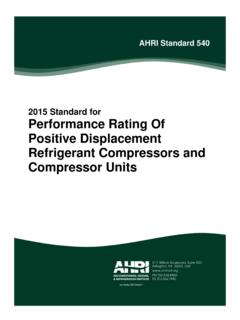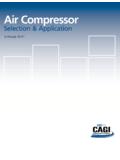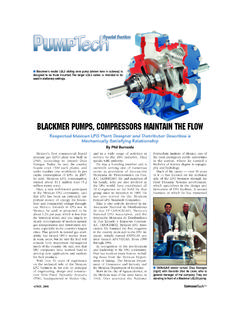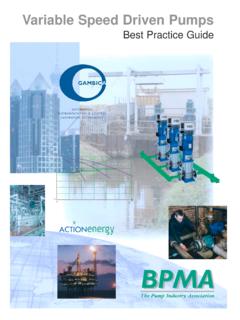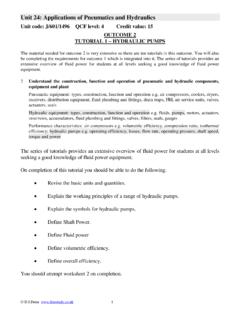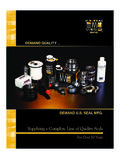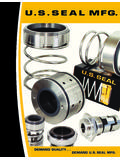Transcription of Types and Performance of Pumps and Compressors
1 UNESCO EOLSSSAMPLE CHAPTERSMECHANICAL ENGINEERING Types and Performance of Pumps and Compressors Essam E. Khalil Encyclopedia of Life Support Systems (EOLSS) Types AND Performance OF Pumps AND Compressors Essam E. Khalil Cairo University, Cairo Egypt Keywords: Pumps , Compressors , Turbomachinery Contents 1. Classifications of Pumps Selecting between Centrifugal Pumps and Positive Displacement Pumps Centrifugal Pumps 2. Pumps Basic Principles Geometric Notation Cascades Flow Notation Specific Speed Pump Geometries Energy Balance Idealized Noncavitating Pump Performance Several Specific Impellers and Pumps 3. Pumps Operation 4. Compressors Glossary Bibliography Biographical Sketch Summary The present chapter attempts to briefly describe an important application of fluid flow in turbo machines with emphases on Pumps and Compressors as two of the more important machines that are used in our everyday life.
2 These can be as small as a fist or as large as hydro power plants. The book makes distinction between the various Types based on theory of operation such as centrifugal Pumps and Positive Displacement Pumps . Classifications based on Mechanical Efficiency, Net Positive Suction Head NPSH are highlighted. The more general affinity laws are briefly described with some solved examples. An important phenomenon that occurs frequently in Pumps , namely cavitation is analyzed . Pumps operations and Performance characteristics are also discussed. Compressors are briefly described as they bear the same basic features as Pumps with more description of Performance and designs. 1. Classifications of Pumps Selecting between Centrifugal Pumps and Positive Displacement Pumps Pumps are in general classified as Centrifugal Pumps or Positive Displacement Pumps . UNESCO EOLSSSAMPLE CHAPTERSMECHANICAL ENGINEERING Types and Performance of Pumps and Compressors Essam E.
3 Khalil Encyclopedia of Life Support Systems (EOLSS) Centrifugal Pumps The centrifugal pump produces a head and a flow by increasing the velocity of the liquid through the machine with the help of a rotating vane impeller. The centrifugal pump can be classified as: End suction pump In-line pump Double suction pump Vertical multistage pump Horizontal multistage pump Submersible Pumps Self-priming Pumps Axial-flow Pumps Regenerative Pumps Positive Displacement Pumps The positive displacement pump operates by alternating of filling a cavity and then displacing a given volume of liquid. The positive displacement pump delivers a constant volume of liquid against varying discharge pressure or head. The positive displacement pump can be classified as: Reciprocating Pumps Power Pumps Steam Pumps Rotary Pumps Selecting between Centrifugal or Positive Displacement Pumps Selecting between a Centrifugal Pump or a Positive Displacement Pump is not always straight forward.
4 Flow Rate and Pressure Head The two Types of Pumps behave very differently regarding pressure head and flow rate: The Centrifugal Pump has varying flow depending on the system pressure or head The Positive Displacement Pump has more or less a constant flow regardless of the system pressure or head. Positive Displacement Pumps generally give more pressure than Centrifugal Pumps . Capacity and Viscosity Another major difference between the pump Types is the effect of viscosity on the capacity: In the Centrifugal Pump the flow is reduced when the viscosity is increased In the Positive Displacement Pump the flow is increased when viscosity is increased UNESCO EOLSSSAMPLE CHAPTERSMECHANICAL ENGINEERING Types and Performance of Pumps and Compressors Essam E. Khalil Encyclopedia of Life Support Systems (EOLSS) Liquids with high viscosity fill the clearances of a Positive Displacement Pump causing a higher volumetric efficiency and a Positive Displacement Pump is better suited for high viscosity applications.
5 A Centrifugal Pump becomes very inefficient at even modest viscosity. Mechanical Efficiency The Pumps behave differently considering mechanical efficiency as well. 1. Changing the system pressure or head has little or no effect on the flow rate in the Positive Displacement Pump 2. Changing the system pressure or head has a dramatic effect on the flow rate in the Centrifugal Pump Net Positive Suction Head - NPSH Another consideration is the Net Positive Suction Head NPSH. 1. In a Centrifugal Pump, NPSH varies as a function of flow determined by pressure 2. In a Positive Displacement Pump, NPSH varies as a function of flow determined by speed. Reducing the speed of the Positive Displacement Pump, reduces the NPSH Affinity Laws The turbo machine affinity laws are common used for Pumps and fans to calculate capacity, head and power consumption when changing speed or wheels diameters The Affinity Laws of a centrifugal pump or fan express the effect on capacity, head and power consumption of a pump or fan due to Different speed - revolutions per minute (rpm) Geometrically similarity - impeller diameter Changing the Pump or Fan Speed (rpm) Changing the speed (rpm, rev/min) of the pump or fan.
6 Capacity 12 1 2QQ N N= (1) Head ()21212 HHNN= (2) Power ()3121 2 PPN N= (3) UNESCO EOLSSSAMPLE CHAPTERSMECHANICAL ENGINEERING Types and Performance of Pumps and Compressors Essam E. Khalil Encyclopedia of Life Support Systems (EOLSS) Where Q= capacity H= head P= power N= speed If the speed increase with 10% The volume increase 10% The head increase 21% The power increase 33 % Note! This means that if we want to increase the volume flow in an existing system with 10% we have to increase the power with 33%. In general the motor and the power supply must be changed. Changing the Impeller Diameter When effectively changing the impeller diameter from 1D into 2D then: Capacity (Discharge) in l/s becomes ()121 2 QQDD= (4) Head ()21212 HHDD= (5) Power ()3121 2 PPD D= (6) Where D= impeller diameter Example 1- Pump Affinity Laws When Pump Speed Changed (Impeller Size Constant).
7 Assuming the initial flow rate as 100 GPM, the initial head is 100 ft, the initial power is 5 bhp, and the initial speed is 1750 rpm and the final speed 3500 rpm. The final flow capacity can be calculated by transforming : ()()()2121 /100 GPM 3500 rpm / 1750 rpm200 GPMQQNN=== UNESCO EOLSSSAMPLE CHAPTERSMECHANICAL ENGINEERING Types and Performance of Pumps and Compressors Essam E. Khalil Encyclopedia of Life Support Systems (EOLSS) The final head can be calculated by transforming : ()()( )( )()222121 /100 ft3500 rpm / 1750 rpm400 ftHHNN=== The final power consumption can be calculated by transforming : ()()( )( )()332121 /5 bhp3500 rpm / 1750 rpm40 bphPPNN=== When Pump Impeller Diameter Changed (Pump Speed Constant) The impeller diameter is changed from 8" (inch) to 6" (inch). The final flow capacity can be calculated by transforming : ()()()2121/100 GPM 6" / 8"75 GPMQQDD=== The final head can be calculated by transforming : ()()()()()222121/100 ft6" / 8" ftHHDD=== The final power consumption can be calculated by transforming : ()()()()332121 (/)5 bhp6" / 8" What is Cavitation?
8 Cavitation occurs in a fluid flow system when the local static pressure is below the vapor pressure. Cavitation - a common problem that can be observed in Pumps and control valves - causing serious wear and tear and damage. Under the wrong conditions, cavitation will reduce the components life time dramatically. According to the Bernoulli Equation this may happen when the fluid accelerates in a control valve or around a pump impeller. The vaporization itself does not cause the damage; the damage occurs when the vapor almost immediately collapses after evaporation when the velocity is decreased and pressure increased. Figure 1 and 2 show examples of suction side and discharge side cavitation in Pumps . UNESCO EOLSSSAMPLE CHAPTERSMECHANICAL ENGINEERING Types and Performance of Pumps and Compressors Essam E. Khalil Encyclopedia of Life Support Systems (EOLSS) Figure 1.
9 Suction side Cavitation Figure 2. Discharge side Cavitation How to Avoid Cavitation Cavitation can in general be avoided by increasing the distance between the actual local static pressure in the fluid - and the vapor pressure of the fluid at the actual temperature. This can be carried out by: I) Reengineering of Components Initiating High Speed Velocity and Low Static Pressure Cavitation and damage can be avoided by using special components designed for the actual rough conditions: Conditions as huge pressure drops can - with limitations - be handled by Multi Stage Control Valves Difficult pumping conditions - with fluid temperatures close to the vaporization temperature - can be handled with a special pump - working after another principle than the centrifugal pump. II) Increasing the Total or Local Pressure in the System By increasing the total or local pressure in the system, the distance between the static pressure and the vaporization pressure is increased and vaporization and cavitation may be avoided.
10 The ratio between static pressure and the vaporization pressure, an indication of the possibility of vaporization, is often expressed by the Cavitation UNESCO EOLSSSAMPLE CHAPTERSMECHANICAL ENGINEERING Types and Performance of Pumps and Compressors Essam E. Khalil Encyclopedia of Life Support Systems (EOLSS) Number. Unfortunately it may not always be possible to increase the total static pressure due to system classifications or other limitations. Local static pressure in the component may then be increased by lowering the component in the system. Control valves and Pumps should in general be positioned in the lowest part of the systems to maximize the static head. This is common for boiler feeding Pumps receiving hot condensate (water close to 100 oC) from a condensate receiver. III) Reducing the Temperature of the Fluid The vaporization pressure is highly dependable of the fluid temperature.










